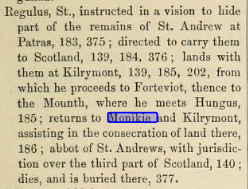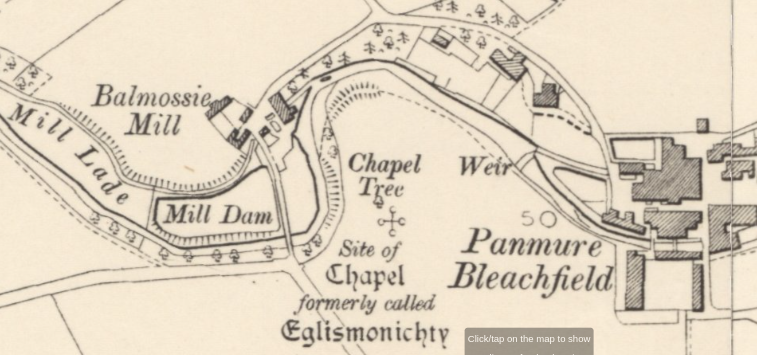Introduction
Our scene is set not far from the main A90 road north from Dundee to Aberdeen, where the road crosses the Dighty river. “Eglismonichity” – a name I suspect long since forgotten by many Monifiethers and unheard of by Dundonians. Eglismonichty, a name all but nearly lost, consigned to our history books, but if we gently blow away the dusty cobwebs, and peer through the darkness to retrace past events, as if almost winding back the hands of time itself, the banks of the Dighty might start to reveal a truly ancient story.
Origins and Pictish times
Two legends that might be considered by the reader, are known simply as the “legend of St Andrew”, and the “legend of St Regulus (St Rule)”. Many other accounts have been written with regard to these legends, and by far is outside the scope of this blog post to write in depth about them nonetheless it would be wrong to completely overlook them.
One such account is that part of the remains of the apostle St Andrew are said to have been brought over from Patras, Greece by St Regulus, further speculation that he may have deposited ancient relics at Eglismonichty, at very least visited “Monikie” when he met King Hungus (Angus).

Kilrymont was known as Muckros [Forest of the pigs] – this was another name for the ness of Fife from the gaelic Muc-Rois – “headland of the pigs”.
Frustrating as any ancient account is, particularly where there is a lack of consistency, always causes an element of doubt. What really happened? Perhaps some things will never be truly known and may be almost as mystical as the Loch Ness monster.
In short, whilst there may be no authentic account of the removal of St Andrew’s relics from Constantinople, nevertheless legend says that ancient relics including some of the bones of St Andrew the apostle were thought to have been brought from Greece to Scotland by some of the earliest Christian believers, the exact timing of events is unclear but between the 4th-9th century AD.
Whilst there is some doubt over exactly where “Monikie” was. One thing that seems certain is that this was not the Monikie most folks know today, as that would have been in the diocese of Brechin, not St Andrews. The Pictish Chronicles mention the name Eglis Monichti (form of Monichi also found), it is thought the Gaelic is “Eaglis manaich-tigh” or “Church of the monks house”.
Language
Before we consider the various spellings of Eglismonichty or possibly consider it’s location, it may be helpful to consider what life was life in 13th century Scotland, for one thing far less populated with some sources estimating a population of 400,000 ∓ 50,000. Long before the days of the industrial revolution or the Internet, life was very much community based with a general focus on working the land/water whether through farming, fishing or the working with the produce of harvest through various mills and storage barns (granges) etc.
Spelling
There appear variant forms of spelling, and possible aliases for this ancient chapelry/settlement some of which are listed here:
Location
The exact location of the chapel, although uncertain, is thought by some to have been north of the Seven Arches viaduct, opposite the old Balmossie Mill adjacent to the old Panmure Bleachworks where the houses in Belltree Gardens are located today.
Timeline
4th – 9th century
Possible early formation of a chapel.
1244 – Bishop David de Berhnam
From the Pontificale Eccelesiae S. Andreae Bishop David de Berhnam, bishop of St Andrews, is said to have had engagements with the ancient chapel of “Eglismonichty” in Monifieth 13 Sept 1244. The purpose of the visit is not fully known, but from the, it appears evident that this chapel was at least dedicated to B.V.Mary.
1320 – Declaration of Arbroath
Letter sent to Pope John XXII asking that Scotland have the right to govern itself and that Robert Bruce be King of Scots.
1321 – Robert Bruce, King of Scotland
In this year Robert Bruce granted nearby lands of Grange and the Mill of Grange to William Durham. Whilst no mention is made specifically of Eglismonichty, the close vicinity of the Grange of Monifieth and the family “Durham of Grange” are doubtless significant.
1483 – Registrum magni sigilli regum Scotorum
From the Register of the Great Seal of Scotland 16 January 1483, we find the following entry in Latin, with translation below. Perhaps serving as an example of Feudal land tenure at work, a 700+ year old system that had seen significant reform in recent times. Suffice to say in this example, the lands of Eglismonichty at one time independent appear to have become united under one domain.
RMS vol 2, #1539
REX – confirmavit cartam Archibaldi comitis Angusie, domini de Dowgles ac baronie et regalitatis de Kerymure, – [ qua concessit ALEXANDRO LUVALE de Ballummy, et heredibus ejus, terras de Eglismonichto, Balmossy, le Brachen, cum duabus partibus terrarum de Kirktoun de Monyfuth, et Justileys (Justisleis), cum molendinis earundem, infra regalitatem de Kerymure, vic. Forfar; quequidem terre molendina (exceptis 5 merc. terrarum de Kirktoun de Monyfuth) fuerunt dicti Alex. hereditare, et que 5 merc. terr fuerant Jonete Luvaile, sororis dicti Alex., herediatarie ; et quas dicti Alex et Joneta in manus dicti comitis resignaverunt, et quas in unum dominium Eglismonichto dictus comes incorporavit et univit :- REDDEND, unum denarium argenti nomine albe firme :- TEST. consanguineis dicti com, Joh. Lyndesay de Cowintoune, Wil. de Carmychell de eodem, Arch. de Douglas avunculo dicti comitis, Joh. Inglis de Scrogtoune, D. Joh. Fresale preposito de Abirnethy, Rob. Douglas, Tho. Luvail : Apud Edinburgh, 23 Feb 1475 ]
……. (cetera desunt ),,,, x 60
{Google translation:
The king confirmed the charter of Archibald, earl of Angus, lord of the Dowgles and of the barony and royalty of Kerymure, [by which he granted to Alexander Luval de Ballummy, and his heirs, the lands of Eglismonicht, Balmossy, le Brachen, with two parts of the lands of Kirktoun de Monyfuth, and Justileys (Justisleis), with the same mills, under the royalty of Kerymure, vic. Forfar; for the mill lands (with the exception of 5 merks of land from Kirktoun de Monyfuth) were the said Alex. to inherit, and that 5 merc. they were terr of Jonete Luvaile, the sister of the said Alex., by inheritance; and which the said Alex and Joneta resigned into the hands of the said count, and which the said count Eglismonichto incorporated and united into one domain:- REDDEND, one penny of silver in the name of the white firm:- TEST. kinsmen of the said com, Joh. Lyndesay of Cowintoune, Wil. de Carmychell on the same, Arch. of Douglas, uncle of the said Earl, Joh. Inglis de Scrogtoune, D. Joh. Fresale, prefect of Abirnethy, Rob. Douglas, Tho. Luvail : At Edinburgh, 23 Feb 1475
}
1560 – Scottish Reformation
Perhaps almost as mysterious as the chapel of Eglismonichty – without doubt a turning point in church history, albeit with origins buried under competing versions of the story.
1561-1565 – Mary Queen of Scots
Just as the Dighty has been witness to turbulent waters that have charted it’s course over time, likewise Scotland has been no stranger to tumultuous times. Following the start of the Scottish Reformation of 1560, Mary would soon return from France to Scotland 19 Aug 1561. In 1564 she granted the lands of the old Greyfriars (Franciscan) monastery in Dundee for use as a burial ground – the area known as the Howff today. It is said that during this time, Mary stayed at Pitkerro House (Castle) 3-4 miles from Eglismonichty during her brief stay at Dundee. Pitkerro House in the ownership of the family Durham of Grange.
1572 – John Knox
John Knox, a leader of the Scottish Reformation died in Edinburgh on 24 November 1572
1581 – Sir David Barclay
David, second baron of Collairnie, had some tough choices to make – to support his queen or to satisfy the insurgent nobles, or “Lords of the Congregation” as they liked to call themselves, who were seeking to dethrone Mary. Ultimately David decided to support Mary and perhaps her visit to Collairnie Tower in January 1565 is testament to this.
In 1581 we learn from sasine records in Register House charters that William Lovell, fiar [not friar!] of Ballumbie, surrendered lands and property including Eglismonichto in favour of “David Barclay of Cullerny” quite probably the same David who simply signed his name “Cullerny”.
David’s grandfather’s mother-in-law was Janet Keith, daughter of William Keith 1st Earl Marischal of Scotland.
1590 – William Durham writ
The following entry can be found in the Exchequer Rolls
Vicecomes respondebit pro £32 de relevio totarum et integrarum terrarum dominicalium de Grange, cum manerie, hortis, pomariis, columbariis, et molendinis, necnon cum molendinis granorum et fullonum ac piscariis earundem tam in mari quam aqua dulci, unacum superioritate terrarum de Balchocher, jacentium infra balliam suam, regi debitis per sasinam datam Willelmo Durhame.
[Google translate: The sheriff shall answer for £32 for the relief of all the lands belonging to the Grange, with the manors, gardens, orchards, dovecots, and mills, as well as with the grain mills and washeries, and the fisheries of the same, both in sea and fresh water, together with the superiority of the lands of Balchocher, lying below his bailiwick, due to the king by a writ given to William Durham. ]
1667 – John Lord Balmerinoch
1667 Disposition by John Lord Balmerinoch, to George Earl of Panmure, in liferent, and Mr. James Maule his second son, in fee, of the lands and barony of Balumbie, Balclocher , Balmossie, com and walkmills of Balmossie, etc., dated 17th July.
[John Elphinstone, second Lord Balmerino was one of the most faithful leaders of the Covenanters, he was admitted burgess & guild brethren of Dundee 8 February 1648]
1669 – George, Earl of Panmure
Crown charter and resignation of lands including Balclocher to George Maule, 3rd Earl of Panmure.

